Strategic Management Literature Review
VerifiedAdded on 2020/01/07
|10
|3414
|403
Literature Review
AI Summary
This assignment requires you to conduct a thorough literature review on the field of strategic management. Analyze various theoretical frameworks, influential studies, and emerging trends within the discipline. The review should demonstrate an understanding of historical developments, core concepts, and contemporary debates in strategic management research.
Contribute Materials
Your contribution can guide someone’s learning journey. Share your
documents today.
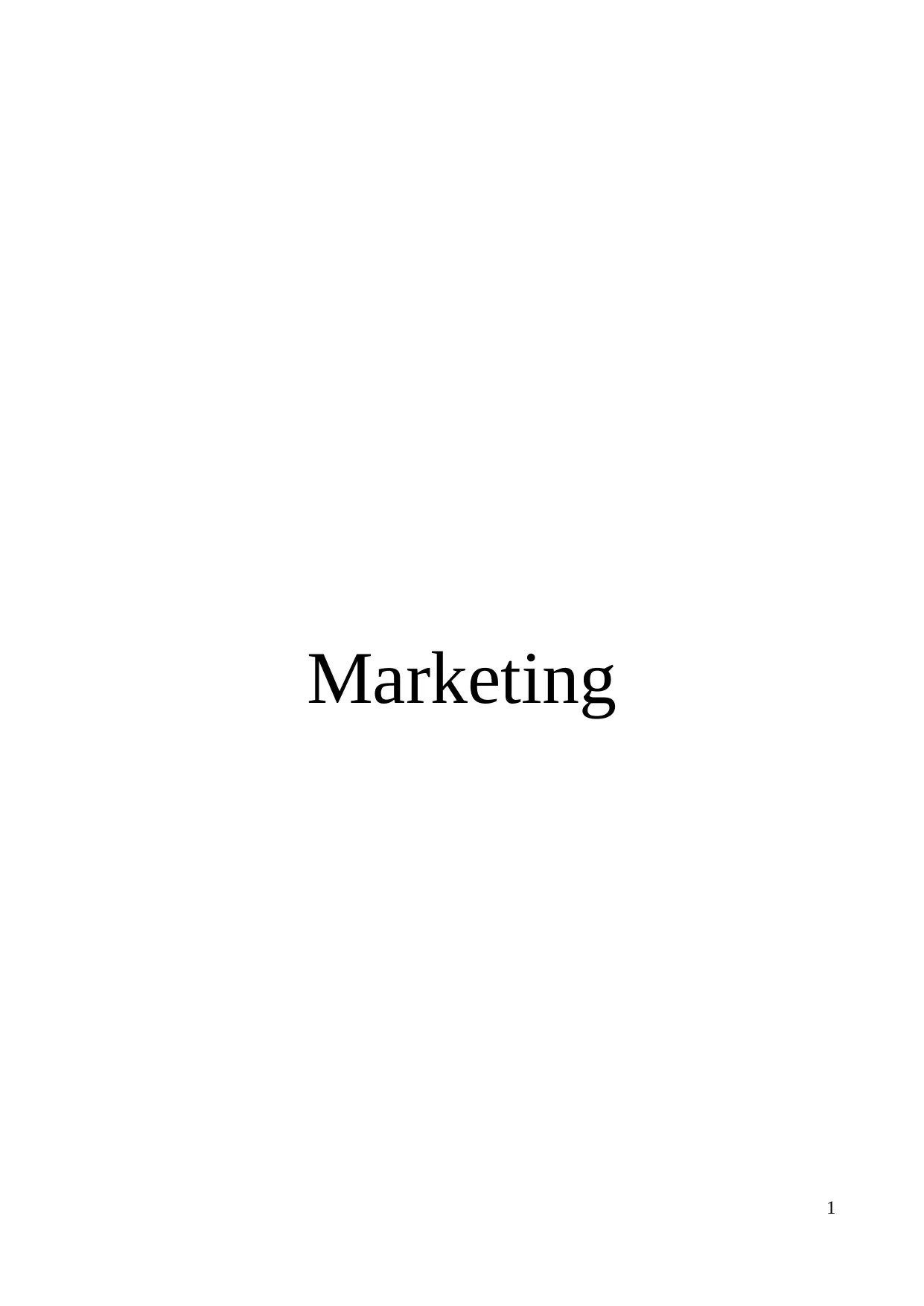
Marketing
1
1
Secure Best Marks with AI Grader
Need help grading? Try our AI Grader for instant feedback on your assignments.
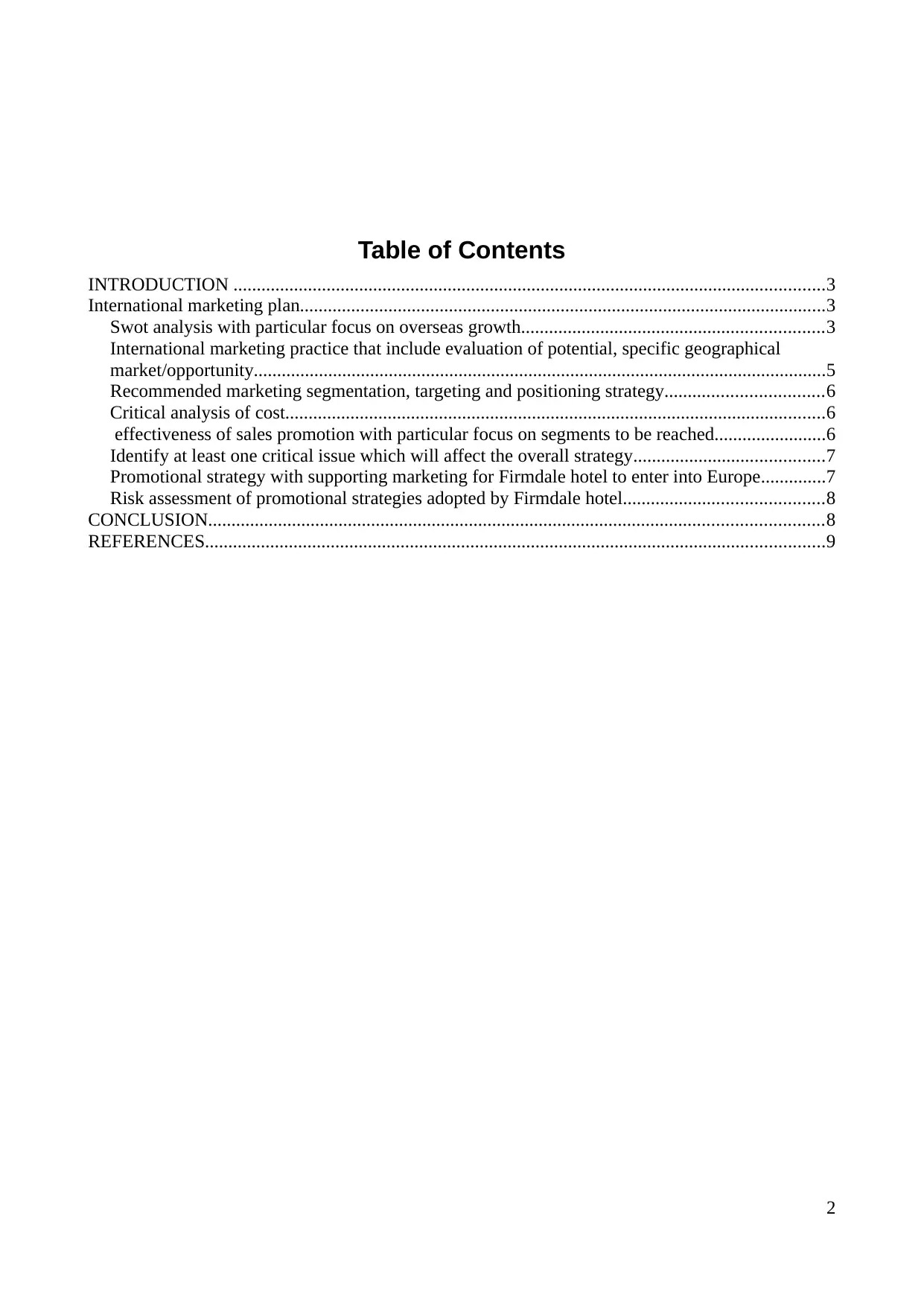
Table of Contents
INTRODUCTION ...............................................................................................................................3
International marketing plan.................................................................................................................3
Swot analysis with particular focus on overseas growth.................................................................3
International marketing practice that include evaluation of potential, specific geographical
market/opportunity...........................................................................................................................5
Recommended marketing segmentation, targeting and positioning strategy..................................6
Critical analysis of cost....................................................................................................................6
effectiveness of sales promotion with particular focus on segments to be reached........................6
Identify at least one critical issue which will affect the overall strategy.........................................7
Promotional strategy with supporting marketing for Firmdale hotel to enter into Europe..............7
Risk assessment of promotional strategies adopted by Firmdale hotel...........................................8
CONCLUSION....................................................................................................................................8
REFERENCES.....................................................................................................................................9
2
INTRODUCTION ...............................................................................................................................3
International marketing plan.................................................................................................................3
Swot analysis with particular focus on overseas growth.................................................................3
International marketing practice that include evaluation of potential, specific geographical
market/opportunity...........................................................................................................................5
Recommended marketing segmentation, targeting and positioning strategy..................................6
Critical analysis of cost....................................................................................................................6
effectiveness of sales promotion with particular focus on segments to be reached........................6
Identify at least one critical issue which will affect the overall strategy.........................................7
Promotional strategy with supporting marketing for Firmdale hotel to enter into Europe..............7
Risk assessment of promotional strategies adopted by Firmdale hotel...........................................8
CONCLUSION....................................................................................................................................8
REFERENCES.....................................................................................................................................9
2
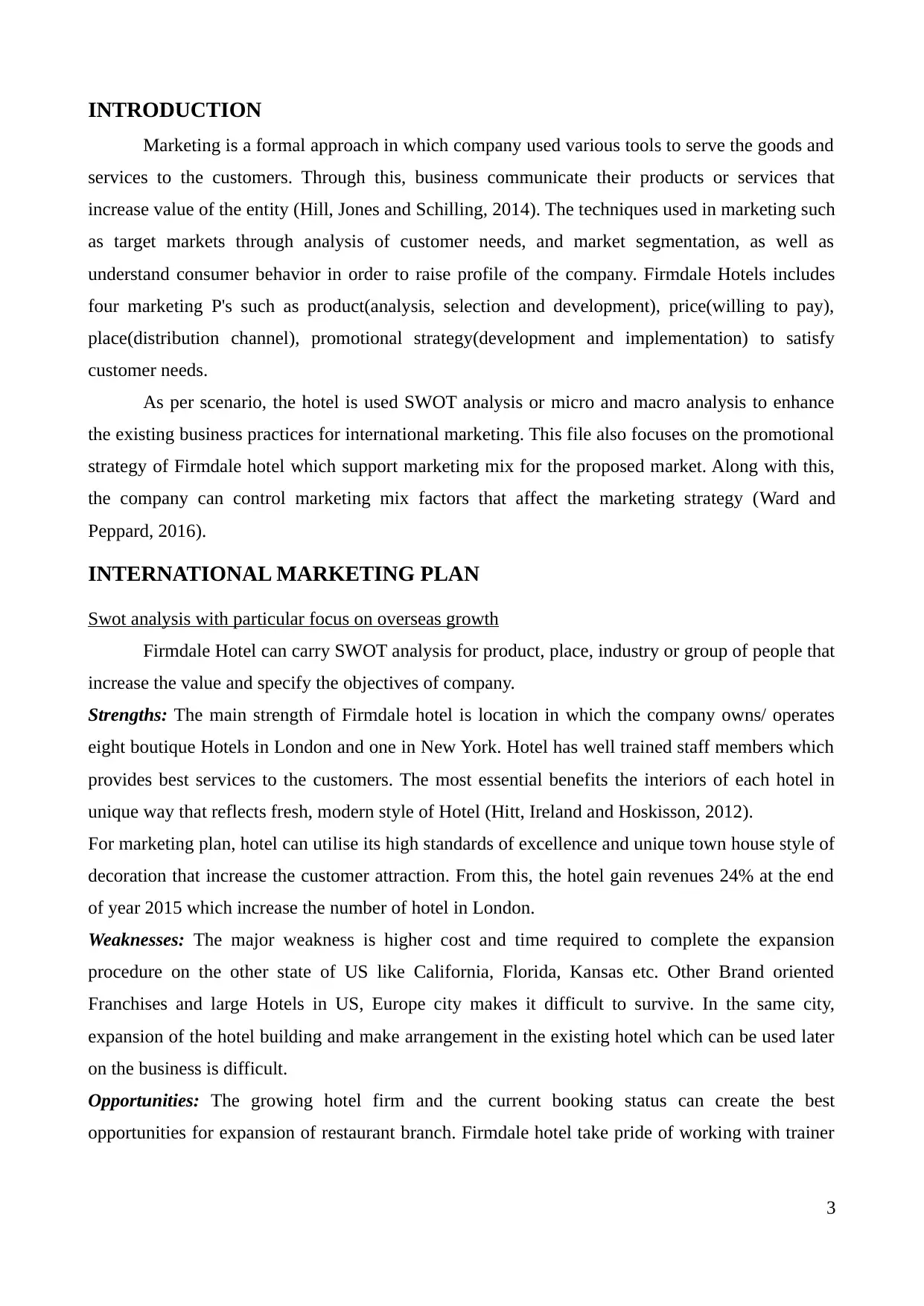
INTRODUCTION
Marketing is a formal approach in which company used various tools to serve the goods and
services to the customers. Through this, business communicate their products or services that
increase value of the entity (Hill, Jones and Schilling, 2014). The techniques used in marketing such
as target markets through analysis of customer needs, and market segmentation, as well as
understand consumer behavior in order to raise profile of the company. Firmdale Hotels includes
four marketing P's such as product(analysis, selection and development), price(willing to pay),
place(distribution channel), promotional strategy(development and implementation) to satisfy
customer needs.
As per scenario, the hotel is used SWOT analysis or micro and macro analysis to enhance
the existing business practices for international marketing. This file also focuses on the promotional
strategy of Firmdale hotel which support marketing mix for the proposed market. Along with this,
the company can control marketing mix factors that affect the marketing strategy (Ward and
Peppard, 2016).
INTERNATIONAL MARKETING PLAN
Swot analysis with particular focus on overseas growth
Firmdale Hotel can carry SWOT analysis for product, place, industry or group of people that
increase the value and specify the objectives of company.
Strengths: The main strength of Firmdale hotel is location in which the company owns/ operates
eight boutique Hotels in London and one in New York. Hotel has well trained staff members which
provides best services to the customers. The most essential benefits the interiors of each hotel in
unique way that reflects fresh, modern style of Hotel (Hitt, Ireland and Hoskisson, 2012).
For marketing plan, hotel can utilise its high standards of excellence and unique town house style of
decoration that increase the customer attraction. From this, the hotel gain revenues 24% at the end
of year 2015 which increase the number of hotel in London.
Weaknesses: The major weakness is higher cost and time required to complete the expansion
procedure on the other state of US like California, Florida, Kansas etc. Other Brand oriented
Franchises and large Hotels in US, Europe city makes it difficult to survive. In the same city,
expansion of the hotel building and make arrangement in the existing hotel which can be used later
on the business is difficult.
Opportunities: The growing hotel firm and the current booking status can create the best
opportunities for expansion of restaurant branch. Firmdale hotel take pride of working with trainer
3
Marketing is a formal approach in which company used various tools to serve the goods and
services to the customers. Through this, business communicate their products or services that
increase value of the entity (Hill, Jones and Schilling, 2014). The techniques used in marketing such
as target markets through analysis of customer needs, and market segmentation, as well as
understand consumer behavior in order to raise profile of the company. Firmdale Hotels includes
four marketing P's such as product(analysis, selection and development), price(willing to pay),
place(distribution channel), promotional strategy(development and implementation) to satisfy
customer needs.
As per scenario, the hotel is used SWOT analysis or micro and macro analysis to enhance
the existing business practices for international marketing. This file also focuses on the promotional
strategy of Firmdale hotel which support marketing mix for the proposed market. Along with this,
the company can control marketing mix factors that affect the marketing strategy (Ward and
Peppard, 2016).
INTERNATIONAL MARKETING PLAN
Swot analysis with particular focus on overseas growth
Firmdale Hotel can carry SWOT analysis for product, place, industry or group of people that
increase the value and specify the objectives of company.
Strengths: The main strength of Firmdale hotel is location in which the company owns/ operates
eight boutique Hotels in London and one in New York. Hotel has well trained staff members which
provides best services to the customers. The most essential benefits the interiors of each hotel in
unique way that reflects fresh, modern style of Hotel (Hitt, Ireland and Hoskisson, 2012).
For marketing plan, hotel can utilise its high standards of excellence and unique town house style of
decoration that increase the customer attraction. From this, the hotel gain revenues 24% at the end
of year 2015 which increase the number of hotel in London.
Weaknesses: The major weakness is higher cost and time required to complete the expansion
procedure on the other state of US like California, Florida, Kansas etc. Other Brand oriented
Franchises and large Hotels in US, Europe city makes it difficult to survive. In the same city,
expansion of the hotel building and make arrangement in the existing hotel which can be used later
on the business is difficult.
Opportunities: The growing hotel firm and the current booking status can create the best
opportunities for expansion of restaurant branch. Firmdale hotel take pride of working with trainer
3
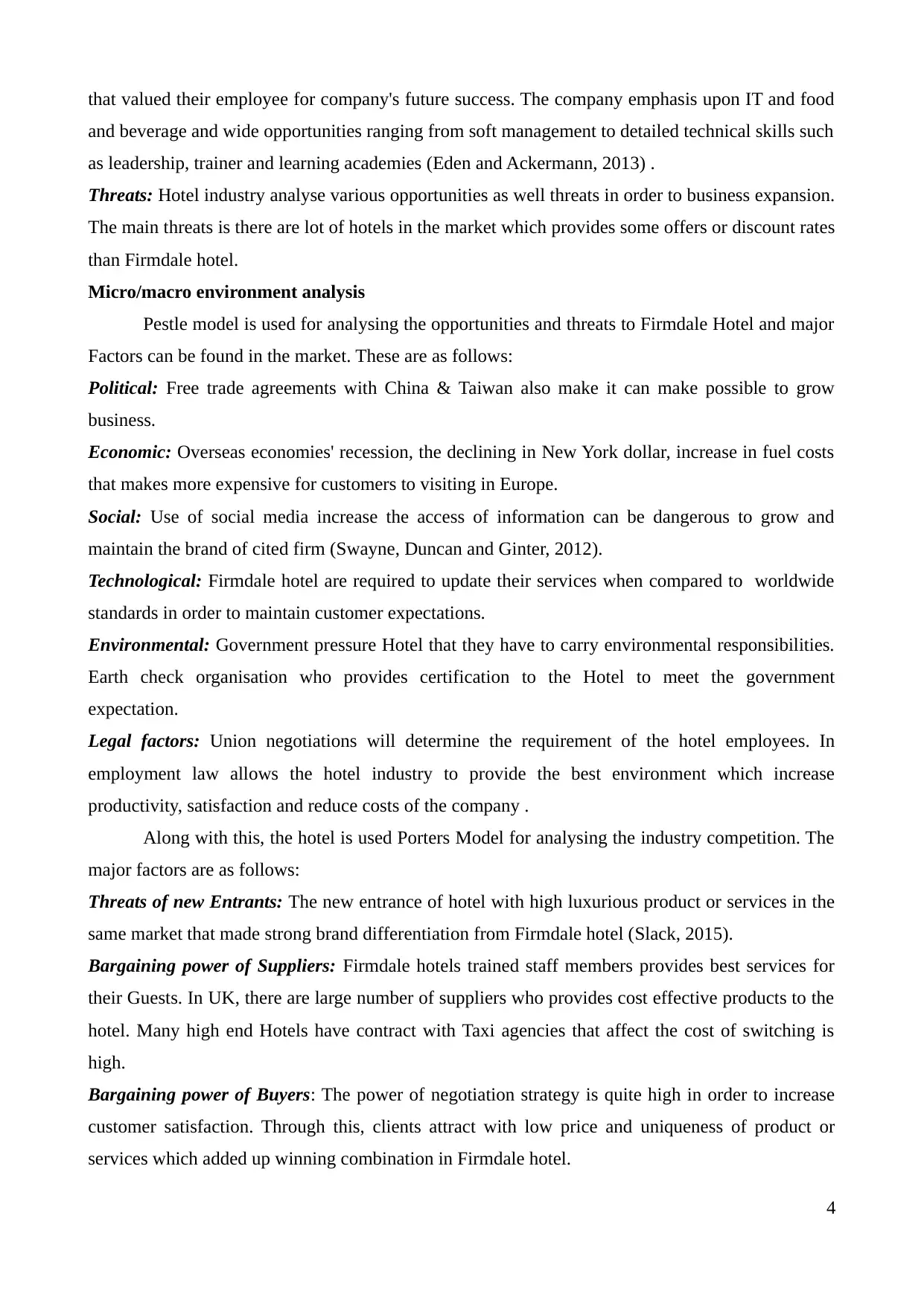
that valued their employee for company's future success. The company emphasis upon IT and food
and beverage and wide opportunities ranging from soft management to detailed technical skills such
as leadership, trainer and learning academies (Eden and Ackermann, 2013) .
Threats: Hotel industry analyse various opportunities as well threats in order to business expansion.
The main threats is there are lot of hotels in the market which provides some offers or discount rates
than Firmdale hotel.
Micro/macro environment analysis
Pestle model is used for analysing the opportunities and threats to Firmdale Hotel and major
Factors can be found in the market. These are as follows:
Political: Free trade agreements with China & Taiwan also make it can make possible to grow
business.
Economic: Overseas economies' recession, the declining in New York dollar, increase in fuel costs
that makes more expensive for customers to visiting in Europe.
Social: Use of social media increase the access of information can be dangerous to grow and
maintain the brand of cited firm (Swayne, Duncan and Ginter, 2012).
Technological: Firmdale hotel are required to update their services when compared to worldwide
standards in order to maintain customer expectations.
Environmental: Government pressure Hotel that they have to carry environmental responsibilities.
Earth check organisation who provides certification to the Hotel to meet the government
expectation.
Legal factors: Union negotiations will determine the requirement of the hotel employees. In
employment law allows the hotel industry to provide the best environment which increase
productivity, satisfaction and reduce costs of the company .
Along with this, the hotel is used Porters Model for analysing the industry competition. The
major factors are as follows:
Threats of new Entrants: The new entrance of hotel with high luxurious product or services in the
same market that made strong brand differentiation from Firmdale hotel (Slack, 2015).
Bargaining power of Suppliers: Firmdale hotels trained staff members provides best services for
their Guests. In UK, there are large number of suppliers who provides cost effective products to the
hotel. Many high end Hotels have contract with Taxi agencies that affect the cost of switching is
high.
Bargaining power of Buyers: The power of negotiation strategy is quite high in order to increase
customer satisfaction. Through this, clients attract with low price and uniqueness of product or
services which added up winning combination in Firmdale hotel.
4
and beverage and wide opportunities ranging from soft management to detailed technical skills such
as leadership, trainer and learning academies (Eden and Ackermann, 2013) .
Threats: Hotel industry analyse various opportunities as well threats in order to business expansion.
The main threats is there are lot of hotels in the market which provides some offers or discount rates
than Firmdale hotel.
Micro/macro environment analysis
Pestle model is used for analysing the opportunities and threats to Firmdale Hotel and major
Factors can be found in the market. These are as follows:
Political: Free trade agreements with China & Taiwan also make it can make possible to grow
business.
Economic: Overseas economies' recession, the declining in New York dollar, increase in fuel costs
that makes more expensive for customers to visiting in Europe.
Social: Use of social media increase the access of information can be dangerous to grow and
maintain the brand of cited firm (Swayne, Duncan and Ginter, 2012).
Technological: Firmdale hotel are required to update their services when compared to worldwide
standards in order to maintain customer expectations.
Environmental: Government pressure Hotel that they have to carry environmental responsibilities.
Earth check organisation who provides certification to the Hotel to meet the government
expectation.
Legal factors: Union negotiations will determine the requirement of the hotel employees. In
employment law allows the hotel industry to provide the best environment which increase
productivity, satisfaction and reduce costs of the company .
Along with this, the hotel is used Porters Model for analysing the industry competition. The
major factors are as follows:
Threats of new Entrants: The new entrance of hotel with high luxurious product or services in the
same market that made strong brand differentiation from Firmdale hotel (Slack, 2015).
Bargaining power of Suppliers: Firmdale hotels trained staff members provides best services for
their Guests. In UK, there are large number of suppliers who provides cost effective products to the
hotel. Many high end Hotels have contract with Taxi agencies that affect the cost of switching is
high.
Bargaining power of Buyers: The power of negotiation strategy is quite high in order to increase
customer satisfaction. Through this, clients attract with low price and uniqueness of product or
services which added up winning combination in Firmdale hotel.
4
Secure Best Marks with AI Grader
Need help grading? Try our AI Grader for instant feedback on your assignments.
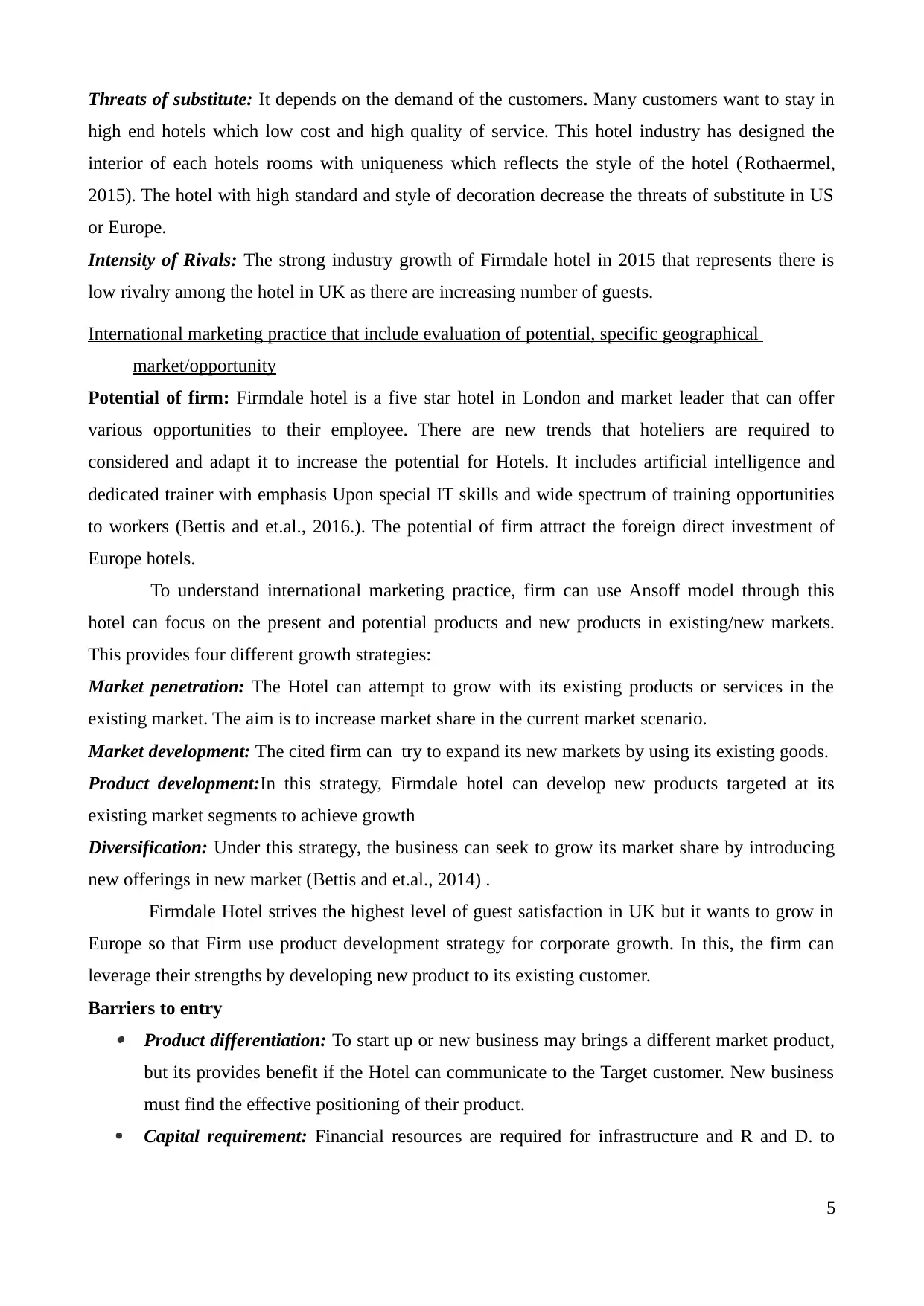
Threats of substitute: It depends on the demand of the customers. Many customers want to stay in
high end hotels which low cost and high quality of service. This hotel industry has designed the
interior of each hotels rooms with uniqueness which reflects the style of the hotel (Rothaermel,
2015). The hotel with high standard and style of decoration decrease the threats of substitute in US
or Europe.
Intensity of Rivals: The strong industry growth of Firmdale hotel in 2015 that represents there is
low rivalry among the hotel in UK as there are increasing number of guests.
International marketing practice that include evaluation of potential, specific geographical
market/opportunity
Potential of firm: Firmdale hotel is a five star hotel in London and market leader that can offer
various opportunities to their employee. There are new trends that hoteliers are required to
considered and adapt it to increase the potential for Hotels. It includes artificial intelligence and
dedicated trainer with emphasis Upon special IT skills and wide spectrum of training opportunities
to workers (Bettis and et.al., 2016.). The potential of firm attract the foreign direct investment of
Europe hotels.
To understand international marketing practice, firm can use Ansoff model through this
hotel can focus on the present and potential products and new products in existing/new markets.
This provides four different growth strategies:
Market penetration: The Hotel can attempt to grow with its existing products or services in the
existing market. The aim is to increase market share in the current market scenario.
Market development: The cited firm can try to expand its new markets by using its existing goods.
Product development:In this strategy, Firmdale hotel can develop new products targeted at its
existing market segments to achieve growth
Diversification: Under this strategy, the business can seek to grow its market share by introducing
new offerings in new market (Bettis and et.al., 2014) .
Firmdale Hotel strives the highest level of guest satisfaction in UK but it wants to grow in
Europe so that Firm use product development strategy for corporate growth. In this, the firm can
leverage their strengths by developing new product to its existing customer.
Barriers to entry Product differentiation: To start up or new business may brings a different market product,
but its provides benefit if the Hotel can communicate to the Target customer. New business
must find the effective positioning of their product.
Capital requirement: Financial resources are required for infrastructure and R and D. to
5
high end hotels which low cost and high quality of service. This hotel industry has designed the
interior of each hotels rooms with uniqueness which reflects the style of the hotel (Rothaermel,
2015). The hotel with high standard and style of decoration decrease the threats of substitute in US
or Europe.
Intensity of Rivals: The strong industry growth of Firmdale hotel in 2015 that represents there is
low rivalry among the hotel in UK as there are increasing number of guests.
International marketing practice that include evaluation of potential, specific geographical
market/opportunity
Potential of firm: Firmdale hotel is a five star hotel in London and market leader that can offer
various opportunities to their employee. There are new trends that hoteliers are required to
considered and adapt it to increase the potential for Hotels. It includes artificial intelligence and
dedicated trainer with emphasis Upon special IT skills and wide spectrum of training opportunities
to workers (Bettis and et.al., 2016.). The potential of firm attract the foreign direct investment of
Europe hotels.
To understand international marketing practice, firm can use Ansoff model through this
hotel can focus on the present and potential products and new products in existing/new markets.
This provides four different growth strategies:
Market penetration: The Hotel can attempt to grow with its existing products or services in the
existing market. The aim is to increase market share in the current market scenario.
Market development: The cited firm can try to expand its new markets by using its existing goods.
Product development:In this strategy, Firmdale hotel can develop new products targeted at its
existing market segments to achieve growth
Diversification: Under this strategy, the business can seek to grow its market share by introducing
new offerings in new market (Bettis and et.al., 2014) .
Firmdale Hotel strives the highest level of guest satisfaction in UK but it wants to grow in
Europe so that Firm use product development strategy for corporate growth. In this, the firm can
leverage their strengths by developing new product to its existing customer.
Barriers to entry Product differentiation: To start up or new business may brings a different market product,
but its provides benefit if the Hotel can communicate to the Target customer. New business
must find the effective positioning of their product.
Capital requirement: Financial resources are required for infrastructure and R and D. to
5
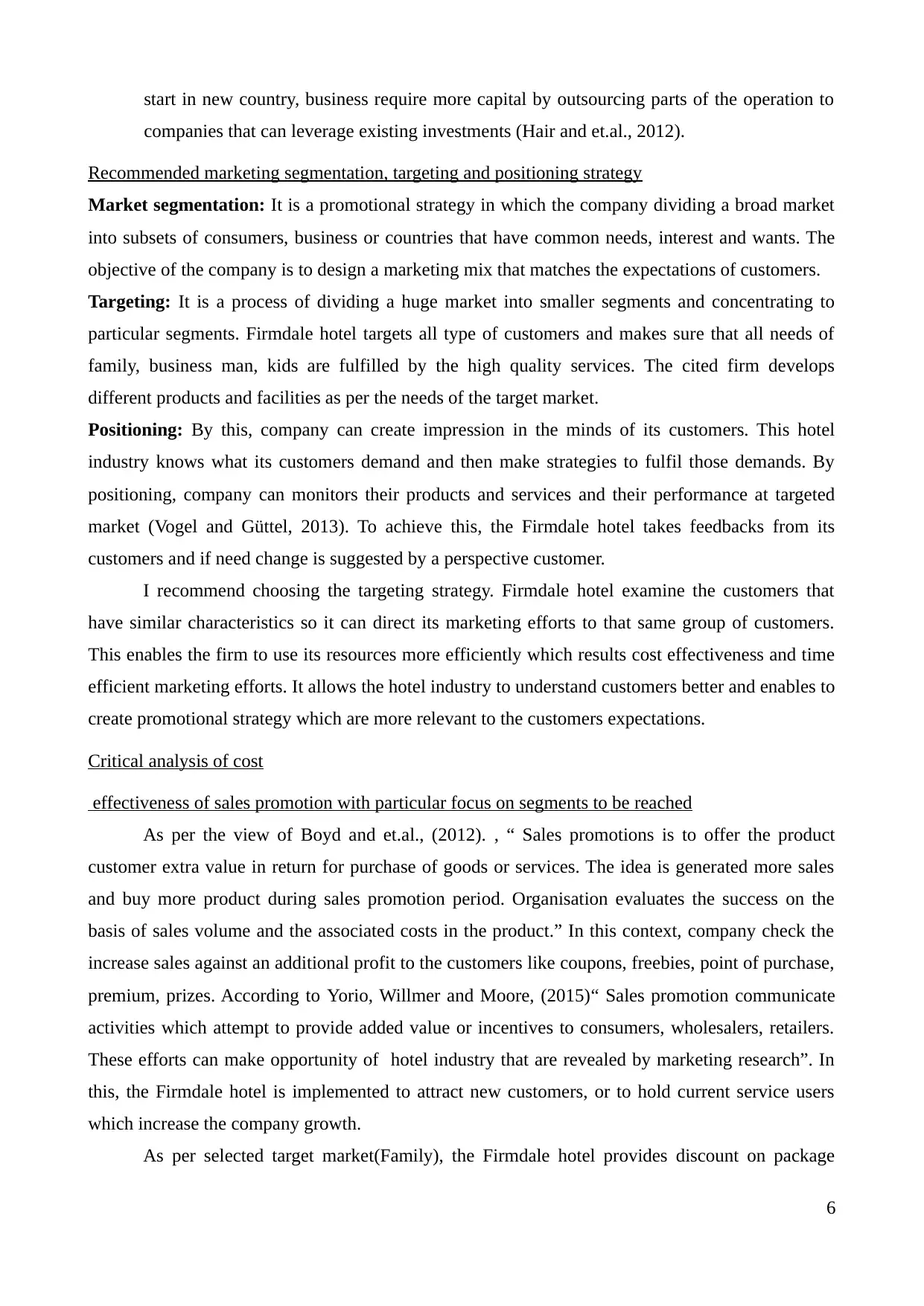
start in new country, business require more capital by outsourcing parts of the operation to
companies that can leverage existing investments (Hair and et.al., 2012).
Recommended marketing segmentation, targeting and positioning strategy
Market segmentation: It is a promotional strategy in which the company dividing a broad market
into subsets of consumers, business or countries that have common needs, interest and wants. The
objective of the company is to design a marketing mix that matches the expectations of customers.
Targeting: It is a process of dividing a huge market into smaller segments and concentrating to
particular segments. Firmdale hotel targets all type of customers and makes sure that all needs of
family, business man, kids are fulfilled by the high quality services. The cited firm develops
different products and facilities as per the needs of the target market.
Positioning: By this, company can create impression in the minds of its customers. This hotel
industry knows what its customers demand and then make strategies to fulfil those demands. By
positioning, company can monitors their products and services and their performance at targeted
market (Vogel and Güttel, 2013). To achieve this, the Firmdale hotel takes feedbacks from its
customers and if need change is suggested by a perspective customer.
I recommend choosing the targeting strategy. Firmdale hotel examine the customers that
have similar characteristics so it can direct its marketing efforts to that same group of customers.
This enables the firm to use its resources more efficiently which results cost effectiveness and time
efficient marketing efforts. It allows the hotel industry to understand customers better and enables to
create promotional strategy which are more relevant to the customers expectations.
Critical analysis of cost
effectiveness of sales promotion with particular focus on segments to be reached
As per the view of Boyd and et.al., (2012). , “ Sales promotions is to offer the product
customer extra value in return for purchase of goods or services. The idea is generated more sales
and buy more product during sales promotion period. Organisation evaluates the success on the
basis of sales volume and the associated costs in the product.” In this context, company check the
increase sales against an additional profit to the customers like coupons, freebies, point of purchase,
premium, prizes. According to Yorio, Willmer and Moore, (2015)“ Sales promotion communicate
activities which attempt to provide added value or incentives to consumers, wholesalers, retailers.
These efforts can make opportunity of hotel industry that are revealed by marketing research”. In
this, the Firmdale hotel is implemented to attract new customers, or to hold current service users
which increase the company growth.
As per selected target market(Family), the Firmdale hotel provides discount on package
6
companies that can leverage existing investments (Hair and et.al., 2012).
Recommended marketing segmentation, targeting and positioning strategy
Market segmentation: It is a promotional strategy in which the company dividing a broad market
into subsets of consumers, business or countries that have common needs, interest and wants. The
objective of the company is to design a marketing mix that matches the expectations of customers.
Targeting: It is a process of dividing a huge market into smaller segments and concentrating to
particular segments. Firmdale hotel targets all type of customers and makes sure that all needs of
family, business man, kids are fulfilled by the high quality services. The cited firm develops
different products and facilities as per the needs of the target market.
Positioning: By this, company can create impression in the minds of its customers. This hotel
industry knows what its customers demand and then make strategies to fulfil those demands. By
positioning, company can monitors their products and services and their performance at targeted
market (Vogel and Güttel, 2013). To achieve this, the Firmdale hotel takes feedbacks from its
customers and if need change is suggested by a perspective customer.
I recommend choosing the targeting strategy. Firmdale hotel examine the customers that
have similar characteristics so it can direct its marketing efforts to that same group of customers.
This enables the firm to use its resources more efficiently which results cost effectiveness and time
efficient marketing efforts. It allows the hotel industry to understand customers better and enables to
create promotional strategy which are more relevant to the customers expectations.
Critical analysis of cost
effectiveness of sales promotion with particular focus on segments to be reached
As per the view of Boyd and et.al., (2012). , “ Sales promotions is to offer the product
customer extra value in return for purchase of goods or services. The idea is generated more sales
and buy more product during sales promotion period. Organisation evaluates the success on the
basis of sales volume and the associated costs in the product.” In this context, company check the
increase sales against an additional profit to the customers like coupons, freebies, point of purchase,
premium, prizes. According to Yorio, Willmer and Moore, (2015)“ Sales promotion communicate
activities which attempt to provide added value or incentives to consumers, wholesalers, retailers.
These efforts can make opportunity of hotel industry that are revealed by marketing research”. In
this, the Firmdale hotel is implemented to attract new customers, or to hold current service users
which increase the company growth.
As per selected target market(Family), the Firmdale hotel provides discount on package
6
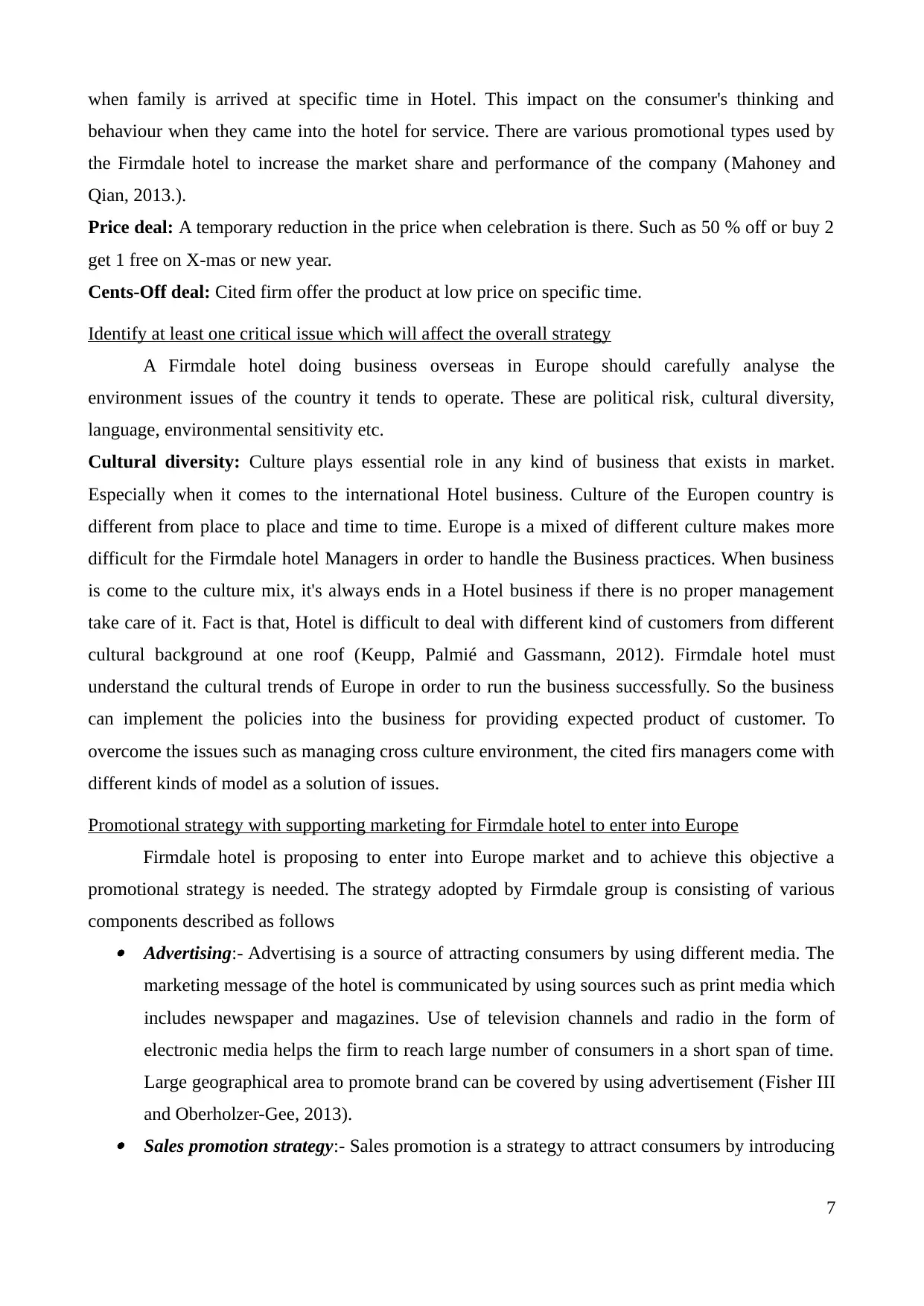
when family is arrived at specific time in Hotel. This impact on the consumer's thinking and
behaviour when they came into the hotel for service. There are various promotional types used by
the Firmdale hotel to increase the market share and performance of the company (Mahoney and
Qian, 2013.).
Price deal: A temporary reduction in the price when celebration is there. Such as 50 % off or buy 2
get 1 free on X-mas or new year.
Cents-Off deal: Cited firm offer the product at low price on specific time.
Identify at least one critical issue which will affect the overall strategy
A Firmdale hotel doing business overseas in Europe should carefully analyse the
environment issues of the country it tends to operate. These are political risk, cultural diversity,
language, environmental sensitivity etc.
Cultural diversity: Culture plays essential role in any kind of business that exists in market.
Especially when it comes to the international Hotel business. Culture of the Europen country is
different from place to place and time to time. Europe is a mixed of different culture makes more
difficult for the Firmdale hotel Managers in order to handle the Business practices. When business
is come to the culture mix, it's always ends in a Hotel business if there is no proper management
take care of it. Fact is that, Hotel is difficult to deal with different kind of customers from different
cultural background at one roof (Keupp, Palmié and Gassmann, 2012). Firmdale hotel must
understand the cultural trends of Europe in order to run the business successfully. So the business
can implement the policies into the business for providing expected product of customer. To
overcome the issues such as managing cross culture environment, the cited firs managers come with
different kinds of model as a solution of issues.
Promotional strategy with supporting marketing for Firmdale hotel to enter into Europe
Firmdale hotel is proposing to enter into Europe market and to achieve this objective a
promotional strategy is needed. The strategy adopted by Firmdale group is consisting of various
components described as follows Advertising:- Advertising is a source of attracting consumers by using different media. The
marketing message of the hotel is communicated by using sources such as print media which
includes newspaper and magazines. Use of television channels and radio in the form of
electronic media helps the firm to reach large number of consumers in a short span of time.
Large geographical area to promote brand can be covered by using advertisement (Fisher III
and Oberholzer-Gee, 2013). Sales promotion strategy:- Sales promotion is a strategy to attract consumers by introducing
7
behaviour when they came into the hotel for service. There are various promotional types used by
the Firmdale hotel to increase the market share and performance of the company (Mahoney and
Qian, 2013.).
Price deal: A temporary reduction in the price when celebration is there. Such as 50 % off or buy 2
get 1 free on X-mas or new year.
Cents-Off deal: Cited firm offer the product at low price on specific time.
Identify at least one critical issue which will affect the overall strategy
A Firmdale hotel doing business overseas in Europe should carefully analyse the
environment issues of the country it tends to operate. These are political risk, cultural diversity,
language, environmental sensitivity etc.
Cultural diversity: Culture plays essential role in any kind of business that exists in market.
Especially when it comes to the international Hotel business. Culture of the Europen country is
different from place to place and time to time. Europe is a mixed of different culture makes more
difficult for the Firmdale hotel Managers in order to handle the Business practices. When business
is come to the culture mix, it's always ends in a Hotel business if there is no proper management
take care of it. Fact is that, Hotel is difficult to deal with different kind of customers from different
cultural background at one roof (Keupp, Palmié and Gassmann, 2012). Firmdale hotel must
understand the cultural trends of Europe in order to run the business successfully. So the business
can implement the policies into the business for providing expected product of customer. To
overcome the issues such as managing cross culture environment, the cited firs managers come with
different kinds of model as a solution of issues.
Promotional strategy with supporting marketing for Firmdale hotel to enter into Europe
Firmdale hotel is proposing to enter into Europe market and to achieve this objective a
promotional strategy is needed. The strategy adopted by Firmdale group is consisting of various
components described as follows Advertising:- Advertising is a source of attracting consumers by using different media. The
marketing message of the hotel is communicated by using sources such as print media which
includes newspaper and magazines. Use of television channels and radio in the form of
electronic media helps the firm to reach large number of consumers in a short span of time.
Large geographical area to promote brand can be covered by using advertisement (Fisher III
and Oberholzer-Gee, 2013). Sales promotion strategy:- Sales promotion is a strategy to attract consumers by introducing
7
Paraphrase This Document
Need a fresh take? Get an instant paraphrase of this document with our AI Paraphraser
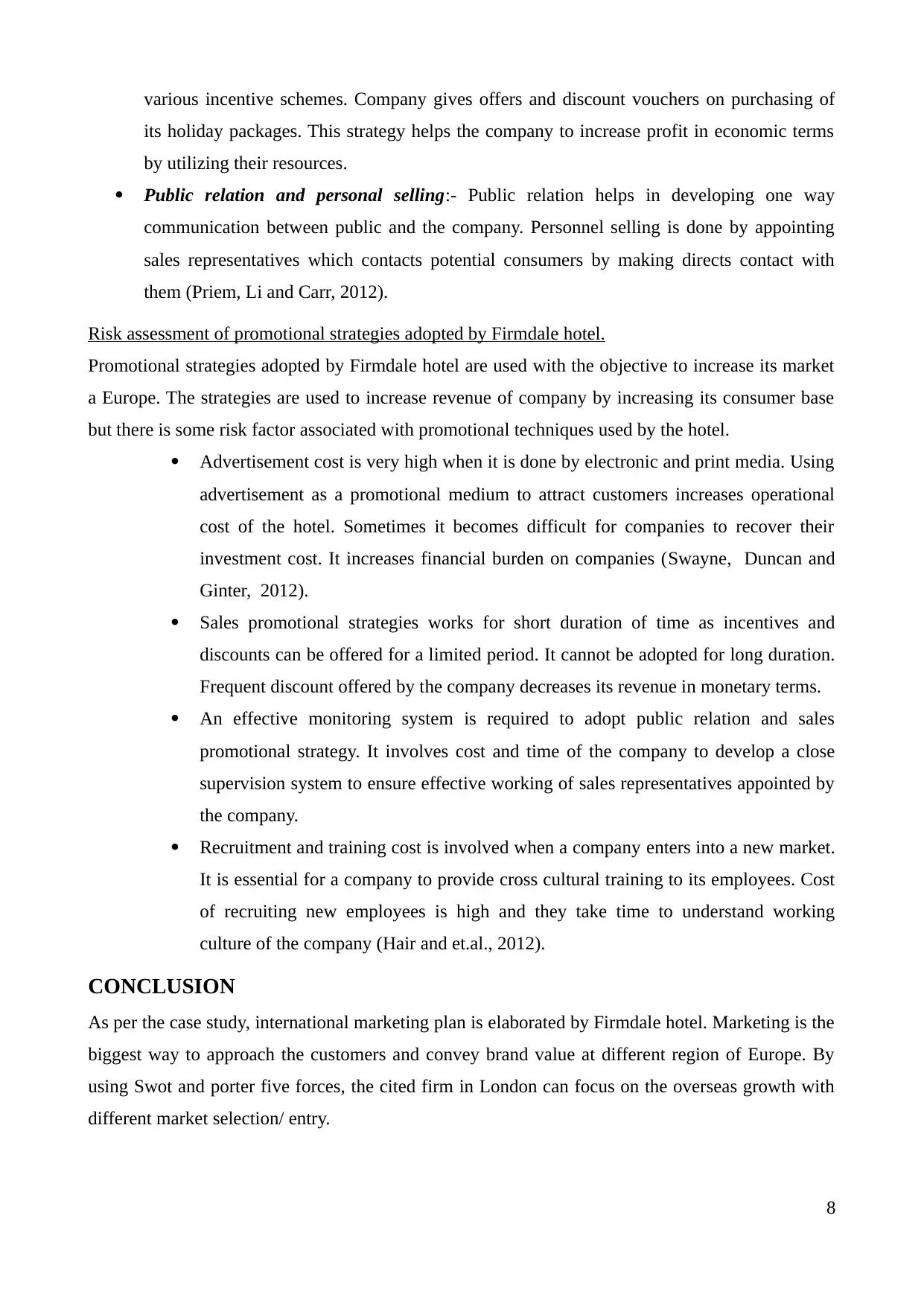
various incentive schemes. Company gives offers and discount vouchers on purchasing of
its holiday packages. This strategy helps the company to increase profit in economic terms
by utilizing their resources.
Public relation and personal selling:- Public relation helps in developing one way
communication between public and the company. Personnel selling is done by appointing
sales representatives which contacts potential consumers by making directs contact with
them (Priem, Li and Carr, 2012).
Risk assessment of promotional strategies adopted by Firmdale hotel.
Promotional strategies adopted by Firmdale hotel are used with the objective to increase its market
a Europe. The strategies are used to increase revenue of company by increasing its consumer base
but there is some risk factor associated with promotional techniques used by the hotel.
Advertisement cost is very high when it is done by electronic and print media. Using
advertisement as a promotional medium to attract customers increases operational
cost of the hotel. Sometimes it becomes difficult for companies to recover their
investment cost. It increases financial burden on companies (Swayne, Duncan and
Ginter, 2012).
Sales promotional strategies works for short duration of time as incentives and
discounts can be offered for a limited period. It cannot be adopted for long duration.
Frequent discount offered by the company decreases its revenue in monetary terms.
An effective monitoring system is required to adopt public relation and sales
promotional strategy. It involves cost and time of the company to develop a close
supervision system to ensure effective working of sales representatives appointed by
the company.
Recruitment and training cost is involved when a company enters into a new market.
It is essential for a company to provide cross cultural training to its employees. Cost
of recruiting new employees is high and they take time to understand working
culture of the company (Hair and et.al., 2012).
CONCLUSION
As per the case study, international marketing plan is elaborated by Firmdale hotel. Marketing is the
biggest way to approach the customers and convey brand value at different region of Europe. By
using Swot and porter five forces, the cited firm in London can focus on the overseas growth with
different market selection/ entry.
8
its holiday packages. This strategy helps the company to increase profit in economic terms
by utilizing their resources.
Public relation and personal selling:- Public relation helps in developing one way
communication between public and the company. Personnel selling is done by appointing
sales representatives which contacts potential consumers by making directs contact with
them (Priem, Li and Carr, 2012).
Risk assessment of promotional strategies adopted by Firmdale hotel.
Promotional strategies adopted by Firmdale hotel are used with the objective to increase its market
a Europe. The strategies are used to increase revenue of company by increasing its consumer base
but there is some risk factor associated with promotional techniques used by the hotel.
Advertisement cost is very high when it is done by electronic and print media. Using
advertisement as a promotional medium to attract customers increases operational
cost of the hotel. Sometimes it becomes difficult for companies to recover their
investment cost. It increases financial burden on companies (Swayne, Duncan and
Ginter, 2012).
Sales promotional strategies works for short duration of time as incentives and
discounts can be offered for a limited period. It cannot be adopted for long duration.
Frequent discount offered by the company decreases its revenue in monetary terms.
An effective monitoring system is required to adopt public relation and sales
promotional strategy. It involves cost and time of the company to develop a close
supervision system to ensure effective working of sales representatives appointed by
the company.
Recruitment and training cost is involved when a company enters into a new market.
It is essential for a company to provide cross cultural training to its employees. Cost
of recruiting new employees is high and they take time to understand working
culture of the company (Hair and et.al., 2012).
CONCLUSION
As per the case study, international marketing plan is elaborated by Firmdale hotel. Marketing is the
biggest way to approach the customers and convey brand value at different region of Europe. By
using Swot and porter five forces, the cited firm in London can focus on the overseas growth with
different market selection/ entry.
8
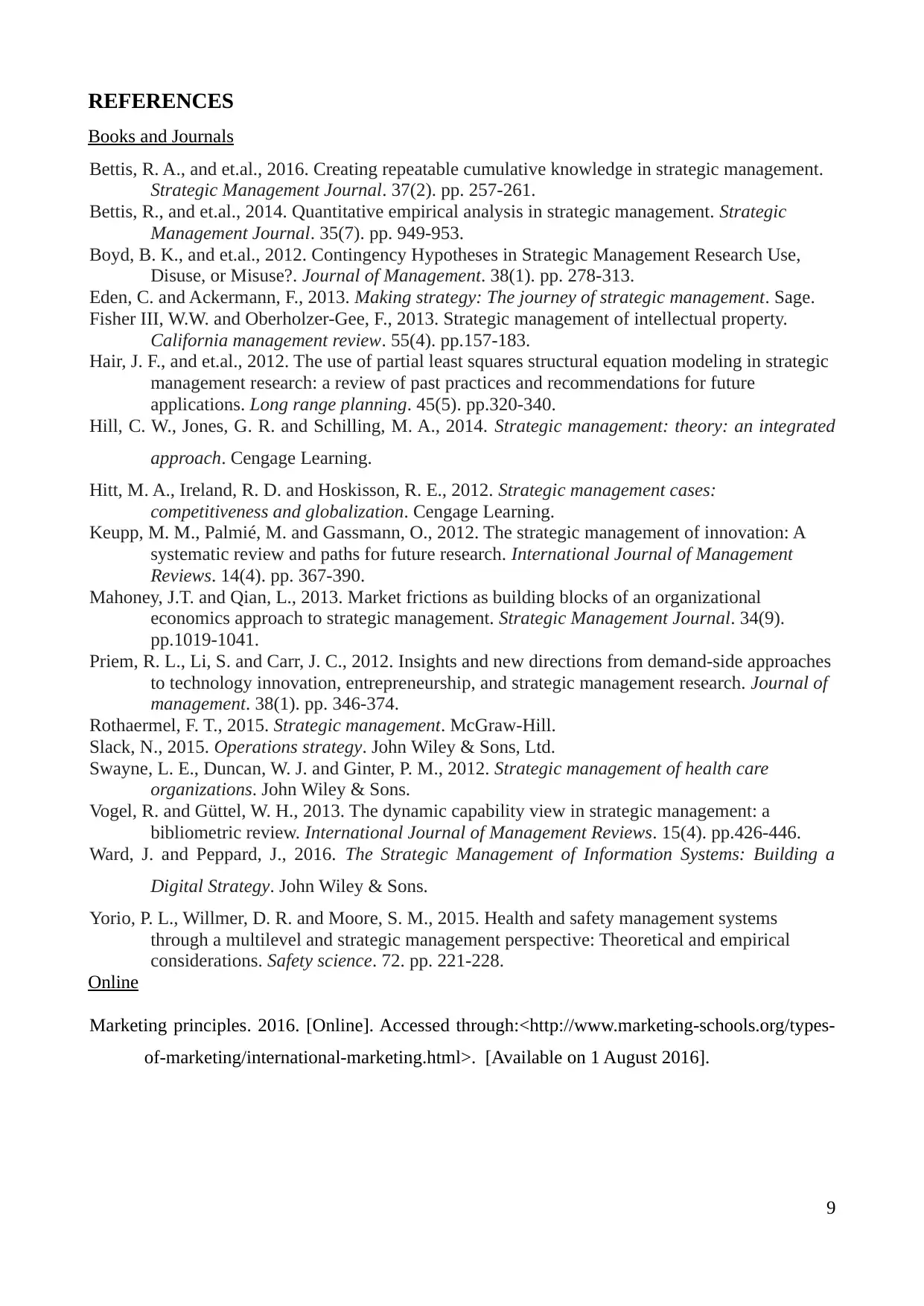
REFERENCES
Books and Journals
Bettis, R. A., and et.al., 2016. Creating repeatable cumulative knowledge in strategic management.
Strategic Management Journal. 37(2). pp. 257-261.
Bettis, R., and et.al., 2014. Quantitative empirical analysis in strategic management. Strategic
Management Journal. 35(7). pp. 949-953.
Boyd, B. K., and et.al., 2012. Contingency Hypotheses in Strategic Management Research Use,
Disuse, or Misuse?. Journal of Management. 38(1). pp. 278-313.
Eden, C. and Ackermann, F., 2013. Making strategy: The journey of strategic management. Sage.
Fisher III, W.W. and Oberholzer-Gee, F., 2013. Strategic management of intellectual property.
California management review. 55(4). pp.157-183.
Hair, J. F., and et.al., 2012. The use of partial least squares structural equation modeling in strategic
management research: a review of past practices and recommendations for future
applications. Long range planning. 45(5). pp.320-340.
Hill, C. W., Jones, G. R. and Schilling, M. A., 2014. Strategic management: theory: an integrated
approach. Cengage Learning.
Hitt, M. A., Ireland, R. D. and Hoskisson, R. E., 2012. Strategic management cases:
competitiveness and globalization. Cengage Learning.
Keupp, M. M., Palmié, M. and Gassmann, O., 2012. The strategic management of innovation: A
systematic review and paths for future research. International Journal of Management
Reviews. 14(4). pp. 367-390.
Mahoney, J.T. and Qian, L., 2013. Market frictions as building blocks of an organizational
economics approach to strategic management. Strategic Management Journal. 34(9).
pp.1019-1041.
Priem, R. L., Li, S. and Carr, J. C., 2012. Insights and new directions from demand-side approaches
to technology innovation, entrepreneurship, and strategic management research. Journal of
management. 38(1). pp. 346-374.
Rothaermel, F. T., 2015. Strategic management. McGraw-Hill.
Slack, N., 2015. Operations strategy. John Wiley & Sons, Ltd.
Swayne, L. E., Duncan, W. J. and Ginter, P. M., 2012. Strategic management of health care
organizations. John Wiley & Sons.
Vogel, R. and Güttel, W. H., 2013. The dynamic capability view in strategic management: a
bibliometric review. International Journal of Management Reviews. 15(4). pp.426-446.
Ward, J. and Peppard, J., 2016. The Strategic Management of Information Systems: Building a
Digital Strategy. John Wiley & Sons.
Yorio, P. L., Willmer, D. R. and Moore, S. M., 2015. Health and safety management systems
through a multilevel and strategic management perspective: Theoretical and empirical
considerations. Safety science. 72. pp. 221-228.
Online
Marketing principles. 2016. [Online]. Accessed through:<http://www.marketing-schools.org/types-
of-marketing/international-marketing.html>. [Available on 1 August 2016].
9
Books and Journals
Bettis, R. A., and et.al., 2016. Creating repeatable cumulative knowledge in strategic management.
Strategic Management Journal. 37(2). pp. 257-261.
Bettis, R., and et.al., 2014. Quantitative empirical analysis in strategic management. Strategic
Management Journal. 35(7). pp. 949-953.
Boyd, B. K., and et.al., 2012. Contingency Hypotheses in Strategic Management Research Use,
Disuse, or Misuse?. Journal of Management. 38(1). pp. 278-313.
Eden, C. and Ackermann, F., 2013. Making strategy: The journey of strategic management. Sage.
Fisher III, W.W. and Oberholzer-Gee, F., 2013. Strategic management of intellectual property.
California management review. 55(4). pp.157-183.
Hair, J. F., and et.al., 2012. The use of partial least squares structural equation modeling in strategic
management research: a review of past practices and recommendations for future
applications. Long range planning. 45(5). pp.320-340.
Hill, C. W., Jones, G. R. and Schilling, M. A., 2014. Strategic management: theory: an integrated
approach. Cengage Learning.
Hitt, M. A., Ireland, R. D. and Hoskisson, R. E., 2012. Strategic management cases:
competitiveness and globalization. Cengage Learning.
Keupp, M. M., Palmié, M. and Gassmann, O., 2012. The strategic management of innovation: A
systematic review and paths for future research. International Journal of Management
Reviews. 14(4). pp. 367-390.
Mahoney, J.T. and Qian, L., 2013. Market frictions as building blocks of an organizational
economics approach to strategic management. Strategic Management Journal. 34(9).
pp.1019-1041.
Priem, R. L., Li, S. and Carr, J. C., 2012. Insights and new directions from demand-side approaches
to technology innovation, entrepreneurship, and strategic management research. Journal of
management. 38(1). pp. 346-374.
Rothaermel, F. T., 2015. Strategic management. McGraw-Hill.
Slack, N., 2015. Operations strategy. John Wiley & Sons, Ltd.
Swayne, L. E., Duncan, W. J. and Ginter, P. M., 2012. Strategic management of health care
organizations. John Wiley & Sons.
Vogel, R. and Güttel, W. H., 2013. The dynamic capability view in strategic management: a
bibliometric review. International Journal of Management Reviews. 15(4). pp.426-446.
Ward, J. and Peppard, J., 2016. The Strategic Management of Information Systems: Building a
Digital Strategy. John Wiley & Sons.
Yorio, P. L., Willmer, D. R. and Moore, S. M., 2015. Health and safety management systems
through a multilevel and strategic management perspective: Theoretical and empirical
considerations. Safety science. 72. pp. 221-228.
Online
Marketing principles. 2016. [Online]. Accessed through:<http://www.marketing-schools.org/types-
of-marketing/international-marketing.html>. [Available on 1 August 2016].
9

10
1 out of 10
Related Documents
Your All-in-One AI-Powered Toolkit for Academic Success.
+13062052269
info@desklib.com
Available 24*7 on WhatsApp / Email
![[object Object]](/_next/static/media/star-bottom.7253800d.svg)
Unlock your academic potential
© 2024 | Zucol Services PVT LTD | All rights reserved.





